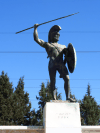
Memorial to the Battle of Thermopylae in 480 BCE. (944k)
From the Thermopylae entry in Wikipedia:
Thermopylae is a place in Greece where a narrow coastal passage existed in antiquity. It derives its name from its hot sulfur springs. In Greek mythology the Hot Gates is one of the entrances to Hades.
Thermopylae is the site of a famous battle between the Greek forces (including Spartans, Thebans and Thespians) and the invading Persian forces, commemorated by Simonides of Ceos in the famous epitaph, "Go tell the Spartans, stranger passing by, That here obedient to their laws we lie." Thermopylae is the only land route large enough to bear any significant traffic between Lokris and Thessaly. To go from north to south along the east coast of the Balkans requires use of the pass, and so Thermopylae has been the site of several battles.
The land is dominated by the coastal floodplain of the Spercheios river and is surrounded by sloping forested limestone mountains. There is continuous deposition of sediment from the river and travertine deposits from the hot springs which has substantially altered the landscape during the past few thousand years. The land surface on which the famous Battle of Thermopylae was fought in 480 BCE is now buried under 20 m (70 ft) of soil. The shoreline has also advanced over the centuries because of the sedimentary deposition. The level of the Malian Gulf was also significantly higher during prehistoric times, and the Spercheios River was significantly shorter. Its shoreline advanced by up to 2 km (1.2 miles) between 2500 BCE and 480 BCE but has still left several narrow passages between the sea and the mountains. The narrowest point on the plain, where the battle was probably fought, would have been less than 100 m (330 ft) wide. Between 480 BCE and the 21st century, the shoreline advanced by as much as 9 km (5.6 miles) in places, eliminating the narrowest points of the pass and considerably increasing the size of the plain around the outlet of the Spercheios.
A highway now splits the pass, with a modern-day monument to King Leonidas I of Sparta on the east side of the highway. It is directly across the road from the hill where Simonides' epitaph to the fallen is engraved in stone at the top. Thermopylae is part of the "horseshoe of Maliakos", also known as the "horseshoe of death". It is the narrowest part of the highway connecting the north and the south of Greece. It has many turns and has been the site of many vehicular accidents.
The hot springs from which the pass derives its name still exist close to the foot of the hill.
The monument has a statue of King Leonidas I with raised spear and shield. Below on the right and left are marble figures of the personified Taigetos, the highest mountain in the Peloponnese and the personified Evrotas, a river flowing through the whole district of Laconia.
All pictures are © Dr. Günther Eichhorn, unless otherwise noted.




This page contains 4 pictures
Here are the links to the other main pages on Greece:
Page last updated on Thu Jul 7 13:12:11 2022 (Mountain Standard Time)
Page last updated on Sat May 18 15:49:51 2024 (Mountain Standard Time)
Thermopylae on soaring.guenther-eichhorn.com